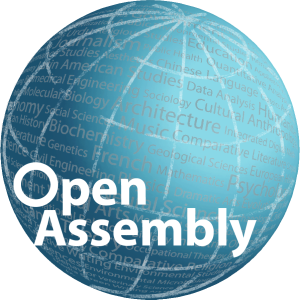This is the second in a semester-long series taking an up-close look at the functionalities and potential of the latest release of Open Assembly’s platform for networked learning in open education environments. Open Assembly is a powerful framework for easily developing or remixing courseware, curating content, and managing research projects. Work on your own—or better yet, in teaching and learning networks you create by inviting others into your process.
After a few weeks of discussion and honing, I’ve finally determined my thesis topic. There’s nothing like a deadline to help things along, and since research grant applications were due this past Sunday, I needed to bring all of my outlying and random thoughts into a more detailed and clear plan. I had a big talk with my advisor, which helped me put together the preliminary bibliography, research abstract, budget and explanation, and project description. And as a double major, I’m incorporating pertinent research that covers both of my majors, into my thesis.
My thesis will explore whether household gas sensors that provide routine notices about air quality are a viable method to abate pollution. I will be experimenting with testing the air quality around campus, sending out reports to a number of students, and then surveying students on whether they believe that being reminded of gas emissions had an effect on the decisions they made. From there, the thesis will explore the cost-benefit issue: Was there enough of a change in decision-making to make household sensors cost-effective? How cheap they would need to be to make “cents?”
All of this work and topic-honing led me to the uploading experience on Open Assembly. Among the important items I uploaded were my materials for the research grant application, which I wanted to make accessible to share with anyone checking out the OA platform or my thesis.
The form to upload documents was tedious to use, but I ended up appreciating the process. It forced me to be extremely organized and fairly detailed about the documents and files I was uploading. I like having all my materials in one place in the cloud, and the ability to organize, or not organize, my “course” or project is intuitive and easy. Modules do not all need to look the same, and I can nest another group of topics with the module. At the same time, I can upload files that do not have a specific location in a module or topic of the course. The versatility really fits me and the project.
The one thing that was not as easy for me was determining copyright. I uploaded a few of my own materials as well as some resources that my teachers had sent from journals. Everything I have uploaded is set to Copyright, “All Rights Reserved,” because I’m not sure how many of the documents are under that type of licence versus a more open type, like Creative Commons. Since I would like for everyone who can to use what I have compiled to the greatest extent possible, I will be looking further into all of the different options concerning licenses of the materials I use and create. Look for a blog post about this soon.
This is just the start, and there’s a long way of exploring and creating to come. Again, if you want to have a closer look to the journey, contact me at julie@openassembly.com. Feel free to leave any comments or questions below!



Leave a comment